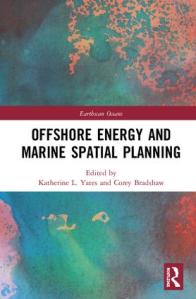
I have the pleasure (and relief) of announcing a new book that’s nearly ready to buy, and I think many readers of CB.com might be interested in what it describes. I know it might be a bit premature to announce it, but given that we’ve just finished the last few details (e.g., and index) and the book is ready to pre-order online, I don’t think it’s too precocious to advertise now.

A little history is in order. The brilliant and hard-working Katherine Yates (now at the University of Salford in Manchester, UK) approached me back in 2014 to assist her with co-editing the volume that she wanted to propose for the Routledge Earthscan Ocean series. I admit that I reluctantly agreed at the time, knowing full well what was in store (anyone who has already edited a book will know what I mean). Being an active researcher in energy and biodiversity (perhaps not so much on the ‘planning’ side per se) certainly helped in my decision.
And yes, there were ups and downs, and sometimes it was a helluva lot of work, but Katherine certainly made my life easier, and she has finally driven the whole thing to completion. She deserves most of the credit.
So what’s the book about? Unless you are already in ‘marine spatial planning’, you might not have heard of this particular type of planning. The book‘s blurb describes it best:
Offshore energy generation is a rapidly growing sector, competing for space in an already busy seascape. This book brings together the ecological, economic, and social implications of the spatial conflict this growth entails. Covering all energy-generation types (wind, wave, tidal, oil, and gas), it explores the direct and indirect impacts the growth of offshore energy generation has on both the marine environment and the existing uses of marine space.
Essentially, the book’s sixteen chapters collectively describe how to do effective marine spatial planning in the context of using the ocean for energy generation (or extraction). While it discusses the biology extensively, the majority of the book gets to the heart of the human dimensions of planning seascape use — which is, I’m sure you can imagine, an increasingly competitive hotbed of divergent values, views, and aspirations.
In fact, without a solid grounding in marine spatial planning, I can safely say that I’m now convinced few economic plans for using the ocean for energy generation or extraction will go very well. In other words, if you have a plan and you just go through the normal channels of obtaining permits, you will soon found out the hard way that many other ocean users might not agree with you.
However, by implementing the approaches outlined in this book, any developer will quickly appreciate that doing things right will not only smooth the way towards a social licence to operate, it will also ensure that the activities are as sustainable as possible and that they maximise the co-location opportunities of multiple ocean users.
There are certainly many remaining problems, such as accepting that compromises are inevitable, the vagueness of the Law of the Sea (and other legal and governance impediments), and the lack of knowledge regarding the long-term effects on marine biological communities of different development pathways. However, the holistic philosophy of marine spatial planning makes these uncertainties far less of an impediment than trying to do things the old-fashioned way.
If you are even remotely involved in the governance, legislation, monitoring, permitting, construction, operation, or planning of an ocean activity that involves energy extraction or generation, you will need this book.



Hi Corey, I’m curious if the volume examines biofouling and the potential translocation of Invasive Marine Species in association with towing offshore structures into position, and the subsequent potential localised translocation via domestic conveyances (i.e. local ships). This is an issue that is being tested at present with profound implications on planning and approval that are only being examined by regulatory authorities in a reactive manner at this stage. Very keen to see how the new books conclusions compare to our experience with recent case-studies in Australia!
Cheers
Pat
LikeLiked by 1 person
Dear Pat, While there is some discussion on the risk of invasive species, the book probably doesn’t go into the detail here that you’d like. It appears that it’s a vastly under-studied component, so we’d be keen to see your results here.
LikeLiked by 1 person